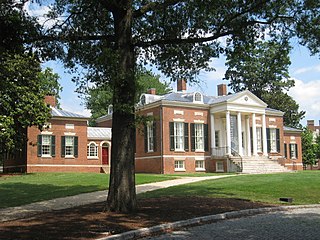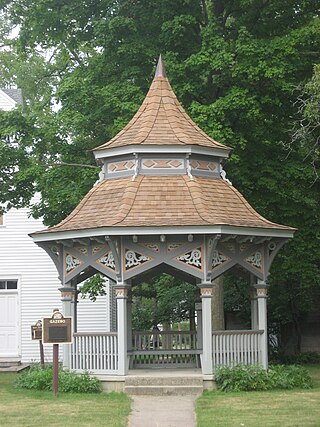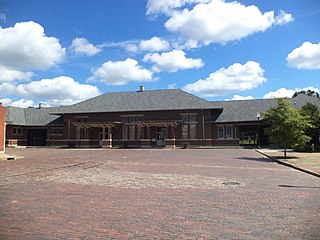This is a list of the more than 2,000 properties and historic districts in the U.S. state of Georgia that are listed on the National Register of Historic Places. Listings are distributed across all of Georgia's 159 counties. Listings for the city of Atlanta are primarily in Fulton County's list but spill over into DeKalb County's list.

This is a list of structures, sites, districts, and objects on the National Register of Historic Places in North Carolina:

The Nevada State Capitol is the capitol building of the U.S. state of Nevada located in the state capital of Carson City at 101 North Carson Street. The building was constructed in the Neoclassical Italianate style between 1869 and 1871. It is listed in the National Register of Historic Places. It is also Nevada Historical Marker number 25.

Wooldridge Park, also known as Wooldridge Square, is an urban park in downtown Austin, Texas. The park consists of a city block containing a natural basin whose sides slope inward to form an amphitheater with a bandstand at its center. The park was added to the National Register of Historic Places in 1979.

The Candler Building is a 17-story high-rise at 127 Peachtree Street, NE, in Atlanta, Georgia. When completed in 1906 by Coca-Cola magnate Asa Griggs Candler, it was the tallest building in the city. This location where Houston joins Peachtree Street was the location of one of the earliest churches in the city which was built on land donated by Judge Reuben Cone in the 1840s. It forms the northern border of Woodruff Park.

The Santa Fe Plaza is a National Historic Landmark in downtown Santa Fe, New Mexico in the style of traditional Spanish-American colonial cities. The plaza, or city square is a gathering place for locals and also a tourist attraction. It is home to annual events including Fiestas de Santa Fe, the Spanish Market, the Santa Fe Bandstand, and the Santa Fe Indian Market.

The Homewood Museum is a historical museum located on the Johns Hopkins University campus in Baltimore, Maryland. It was listed as a National Historic Landmark in 1971, noted as a family home of Maryland's Carroll family. It, along with Evergreen Museum & Library, make up the Johns Hopkins University Museums.

The Savannah Historic District is a large urban U.S. historic district that roughly corresponds to the pre-civil war city limits of Savannah, Georgia. The area was declared a National Historic Landmark District in 1966, and is one of the largest urban, community-wide historic preservation districts in the United States. The district was made in recognition of the Oglethorpe Plan, a unique sort of urban planning begun by James Oglethorpe at the city's founding and propagated for the first century of its growth.

The Georgia State Railroad Museum is a museum in Savannah, Georgia located at a historic Central of Georgia Railway site. It includes parts of the Central of Georgia Railway: Savannah Shops and Terminal Facilities National Historic Landmark District. The complex is considered the most complete antebellum railroad complex in the United States. The museum, located at 655 Louisville Road, is part of a historic district included in the National Register of Historic Places.

Central of Georgia Depot and Trainshed is a former passenger depot and trainshed constructed in 1860 by the Central of Georgia Railway (CofG) before the outbreak of the American Civil War. This pair of buildings was declared a National Historic Landmark in 1976, a listing that was expanded in 1978 to the old Central of Georgia Railway Savannah Shops and Terminal Facilities.

The Van Wert Bandstand is a historic gazebo in Van Wert, a city in the far western portion of the U.S. state of Ohio. Built in 1874, this octagonal bandstand is a wooden structure crafted in the High Gothic Revival style. Among its most distinctive elements is its two-part roof: rising to a central point, the steep roof is split between upper and lower portions by a double cornice with an ornate frieze. Elaborate design continues down below the roof: the eaves underneath the roof's base rest upon carven brackets, which are secured to pillars whose capitals are trimmed with a sawtooth pattern. Finally, the entire roof is supported by a cross-shaped structure that features elements such as three musical notes.

Roberts Park is a 14 acres (5.7 ha) public urban park in Saltaire, West Yorkshire, England. Higher Coach Road, Baildon, is to the north and the park is bounded to the south by the River Aire. A pedestrian footbridge crosses the Aire and links the park to the village of Saltaire. The park is an integral part of the Saltaire World Heritage site.

The Oskaloosa City Park and Band Stand is a nationally recognized historic district located in Oskaloosa, Iowa, United States. It was listed on the National Register of Historic Places in 1983. The listing includes one contributing site and five contributing objects. The town square, which is the site, was part of the original town plat in 1844. Landscaping projects were undertaken in the 1860s, 1911 and 1970–1971. In addition to the landscaping the sidewalks and curbing were installed in 1911. The bandstand in the center was designed by Des Moines architect Frank E. Wetherell, an Oskaloosa native, and built in 1912. The 29-foot (8.8 m) high octagonal structure is composed of concrete, iron and steel.

Albany Railroad Depot Historic District is located at the 100 block of West Roosevelt Avenue in Albany, Georgia, United States, and is governed by the Thronateeska Heritage Center, a 501(c)3 not-for-profit organization incorporated in 1974 for the purpose of historic preservation and science education in Southwest Georgia. The Heritage Plaza includes the Tift Warehouse, the Union Station depot, the Railway Express Agency building and Albany's last remaining brick street and is listed in the National Register of Historic Places (NRHP).

The Transfer House is a historic building located in Central Park in Decatur, Illinois. Built in 1896, the building originally served as a transfer point for Decatur's electric streetcar system. Architect William W. Boyington's design for the building was influenced by a number of Victorian styles, particularly the Richardsonian Romanesque. The building was ultimately moved to Central Park and is now listed on the National Register of Historic Places.

Terminal Station, Macon, Georgia, is a railroad station that was built in 1916, and is located on 5th St. at the end of Cherry St. It was designed in the Beaux-Arts style by architect Alfred T. Fellheimer (1875–1959), prominent for his design of Grand Central Terminal in New York City in 1903. The station building is part of the Macon Historic District, which is listed on the National Register of Historic Places. While no longer an active train station, it has been the location of the Macon Transit Authority bus hub since 2014.

The Central Park Bandstand, also known as the Music Pavilion, is a historic bandshell located within Central Park in Orion, Illinois. The bandstand was built in 1913 following a series of successful outdoor concerts in the park. Local engineer J. C. Ericson built the structure in the then-recently popularized bandshell form, which projected sound toward the audience through its rear wall. The bandstand was completed in three weeks; its opening concert hosted the largest crowd that the park had ever held until that time. From its inception until 1925, the bandstand continued to host concerts, usually once per week; movie screenings and church services were also held at the bandstand. Beginning in 1947, the bandstand became an event stage for the Midwest Corn Show, which later became the Orion Fall Festival; the structure is now mainly used during the festival.

Bandshell Park, also known as City Park and Music Pavilion, is located in Ames, Iowa, United States. It is a nationally recognized historic district that was listed on the National Register of Historic Places in 1999. At the time of its nomination it consisted of six resources, which included one contributing building, one contributing site, two contributing structures, one contributing object, and one non-contributing object. The park, located to the east of the central business district, was gift to the city in 1884 from the C&NW Land Company. The full city block was the first park established in Ames.

The City Square Park Bandstand, at 100 S. 9th St. in Humboldt, Kansas, was built in 1907. It was listed on the National Register of Historic Places in 2014.

The Cumming Bandstand, in front of the Forsyth County Courthouse in Cumming, Georgia, was built in 1915. It was listed on the National Register of Historic Places in 2002.



















